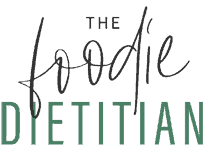Food is meant to be pleasurable and enjoying your food is good for your health! Leave behind the guilt and shame and follow these six tips to find more enjoyment in eating.
What if I told you that eating is meant to be enjoyable? That food is meant to be pleasurable. That eating for satisfaction is actually beneficial for our overall health.
Does this line up with how you’re currently experiencing food and eating? Or does eating for you evoke feelings of guilt, shame, or anxiety?
For many of the folks I work with 1:1, they are not experiencing enjoyment in eating because they are worried about eating the “wrong” things or eating “too much.” And this distress has profound impacts on their mental health. Does this sound familiar to you?
Our culture has conditioned you to believe that food is fuel and nothing more.
But we are meant to enjoy food.
It’s a survival adaptation – if food wasn’t pleasurable, we wouldn’t be incentivized to eat. And we need to eat to survive!
Benefits of Enjoying Eating
Yes, there are benefits to actually enjoying your food!
1. Less likely to “overeat” or eat past fullness. If you choose foods that you think you “should” be eating but aren’t what you’re truly craving, you likely won’t feel satisfied after a meal.
I think of satisfaction like emotional fullness. You can eat a large volume of food and feel physically full but not satisfied or emotionally full. When you’re not satisfied, you’re more likely to keep thinking about food, and keep grabbing for other foods in hopes of satisfying that urge.
This might look like eating a big salad with lots of veggies and chicken when what you really wanted was a caprese sandwich. So you finish your salad feeling physically full but not satisfied so you grab an apple hoping that will help. 20 minutes later you’re still thinking about food so you get some rice cakes and hummus.
Another 20 minutes go by and you wind up eating a whole block of mozzarella cheese because you deprived yourself of what you really wanted and then winded up overdoing it and feeling painfully full. This pendulum swing of restricting and binging is all too common.
2. Improved mental health
When you’re choosing foods you actually enjoy eating and give yourself permission to enjoy them, you’ll decrease feelings of guilt, shame, and anxiety that lead to mental distress. When you look at eating through the lens of joy and pleasure, you’re inviting in more feelings of joy and pleasure!
Research supports this – several studies on Intuitive Eating, a self-care framework which includes a focus on eating for satisfaction, show improvements in depression, self-esteem, negative affect, quality of life, ineffectiveness, anxiety, interpersonal sensitivity, and general wellbeing. To learn more about Intuitive Eating, check out our free beginner’s guide to Intuitive Eating.
3. Improved digestion
Maybe you’ve been told to cut out a bunch of foods to improve your digestion. Or to eat a few select foods to support GI health. But what about the science that shows that enjoying the food you’re eating actually helps support digestion?
When you’re in a state of enjoyment, your parasympathetic nervous system is activated, eliciting a relaxation response. As a result, blood flow and energy goes straight to your GI tract, helping you digest food.
It also tells your pancreas to make and release insulin, helping your body break down sugars into a form your cells can use. This effect on the GI system is why the relaxation response is often referred to as “rest and digest.”
In contrast, if you’re stressed out while eating because you chose something you don’t actually enjoy, this will activate the sympathetic nervous system, which sends blood flow away from the GI tract and to the extremities, often resulting in GI distress.
4. Better nutrient absorption
It makes sense that if digestion improves with enjoying your food that nutrient absorption would improve as well. A research study from the 70’s showed that the more you enjoy the taste of your food, the more nutrients you’ll absorb.
The researchers gave a Southeast Asian dish to both Thai women and Swedish women and measured iron absorption and the Thai women absorbed significantly more iron, which makes sense since they would have enjoyed the meal more! They then gave the Thai women the same dish but pureed into a brown goo and they absorbed 70% less iron than they did previously! Same food. Less enjoyment.
How to Find More Enjoyment in Eating
You are deserving of finding pleasure in eating – try on some of these tips and see if you notice any shifts in how you feel around food!
1. Identify foods that taste good to you.
Write down a list! Many of my clients aren’t even sure what their true food preferences are after years of dieting and eating based on external rules. Start writing down a list of the foods you truly enjoy the taste of, even if they elicit fear or judgment.
Begin to prioritize foods that taste good and choose more foods off of this list!
2. Choose foods that actually sound good to you in the moment.
Are you in the mood for something sweet, salty, or savory?
Crunchy or smooth?
Cold, hot, warm, or room temperature?
Light or heavy?
Ask yourself these questions before eating to help guide you in choosing what sounds good to your body and mind in the moment.
3. Bring more joy to your eating environment.
So often we eat in front of the computer or phone or during a meeting. Or we eat while we’re rushing out the door or in the car while we’re stuck in traffic. How joyless is that?
Now of course eating in these environments is much better than not eating at all! And you can start to slowly prioritize bringing more joy to your eating environment, even if it’s for one meal a day.
Maybe you start with dinner. You light a couple candles. You put out a vase of fresh flowers. You use the nice dishes and glassware. Perhaps you play some calming music while you eat.
All of these small changes can add a lot more enjoyment to your eating experience.
4. Start viewing food as morally neutral.
If you currently label foods as good or bad, healthy or unhealthy, clean or dirty, you’re viewing food through a dichotomous or black-and-white lens. It’s really hard to enjoy food when you think you’re bad or unhealthy for eating it.
Start to challenge your black-and-white thinking around food and name foods as they are – apple is an apple or cookie is a cookie – without labeling them (or yourself for eating them!) as good or bad.
5. Practice mindful eating.
It’s difficult to enjoy food when you’re rushing through it, not really tasting it, or being present for the experience.
Again, you can’t expect to eat perfectly mindful all the time. That’s unrealistic in today’s world. And maybe you can start to tune in just a little more to your eating experience.
Before you begin eating, pause to notice the food in front of you, taking in the colors, textures, and the aroma. While you’re eating, take the time to chew your food thoroughly, noticing the taste sensations that arise. Slow down your eating by checking-in with your body. How is the food tasting? Are you still hungry? Are you getting full?
Engaging your senses while eating can bring more pleasure to the meal.
6. Give yourself permission to experience joy in eating.
We do not live in a culture that values pleasure. In fact, historically, pleasure has been viewed as sinful, indulgent, and gluttonous.
No wonder so many of us (especially women) struggle with embracing and seeking out pleasure in our lives.
I believe that pleasure is our birthright.
But first, we have to believe we our worthy of pleasure.
Write yourself a permission slip – giving yourself permission to experience pleasure in different areas of your life that feel relevant, and be sure to include eating on there.
I give myself permission to experience joy and pleasure in eating and to choose foods that bring me enjoyment.
What would you add to this list? How do you find enjoyment in eating? Is this something you struggle with? Tell me in the comments below!


